#Lise Meitner
Explore tagged Tumblr posts
Text

Meitnerium is named after Lise Meitner, who discovered the process by which unstable atoms split and named it "fission." Its most stable known isotope lasts less than 5 seconds, but there have been unconfirmed reports of meitnerium-282 lasting 67 seconds.
19 notes
·
View notes
Text
1932

1938

1945

#Manhattan Project#enrico fermi#rad lab#Otto Hahn#lise meitner#fritz strassman#oppenheimer#j robert oppenheimer#j. robert oppenheimer#nuclear fission#fission#nuclear#scientists#physicists#niels bohr#ernest rutherford#edward teller#teller ede#ernest lawrence#los alamos#minecraft#minecraft achievements
30 notes
·
View notes
Text
Christopher Nolan’s highly-anticipated movie “Oppenheimer,” set for release July 21, 2023, depicts J. Robert Oppenheimer and his role in the development of the atomic bomb. But while the Manhattan Project wouldn’t have been possible without the work of many accomplished female scientists, the only women seen in the movie’s trailer are either hanging laundry, crying or cheering the men on.The only women featured in the official trailer for Christopher Nolan’s ‘Oppenheimer’ are crying, hanging laundry or supporting the men.
As a physics professor who studies ways to support women in STEM – science, technology, engineering and math – fields and a film studies professor who worked as a screenwriter in Hollywood, we believe the trailer’s depiction of women reinforces stereotypes about who can succeed in science. It also represents a larger trend of women’s contributions in science going unrecognized in modern media.
Lise Meitner: A pioneering role model in physics
The Manhattan Project would not have been possible without the work of physicist Lise Meitner, who discovered nuclear fission. Meitner used Einstein’s E=MC² to calculate how much energy would be released by splitting uranium atoms, and it was that development that would prompt Einstein to sign a letter urging President Franklin Roosevelt to begin the United States’ atomic research program.
Einstein called Meitner the “Madame Curie of Germany” and was one of a pantheon of physicists, from Max Planck to Niels Bohr, who nominated Meitner for a Nobel Prize 48 times during her lifetime.
Meitner never won. Instead, the prize for fission went to Otto Hahn, her male lab partner of 30 years in Berlin. Hahn received the news of his nomination under house arrest in England, where he and other German scientists were being held to determine how far the Third Reich had advanced with its atomic program.
Of Jewish descent, Meitner had been forced to flee the Nazis in 1938 and refused to use this scientific discovery to develop a bomb. Rather, she spent the rest of her life working to promote nuclear disarmament and advocating for the responsible use of nuclear energy.
Meitner was not the only woman who made a significant contribution during this time. But the lack of physics role models like Meitner in popular media leads to real-life consequences. Meitner doesn’t appear as a character in the film, as she was not part of the Manhattan Project, but we hope the script alludes to her groundbreaking work.
A lack of representation
Only around 20% of the undergraduate majors and Ph.D. students in physics are women. The societal stereotypes and biases, expectation of brilliance, lack of role models and chilly culture of physics discourage many talented students from historically marginalized backgrounds, like women, from pursuing physics and related disciplines.
Societal stereotypes and biases influence students even before they enter the classroom. One common stereotype is the idea that genius and brilliance are important factors to succeed in physics. However, genius is often associated with boys, and girls from a young age tend to shy away from fields associated with innate brilliance.
Studies have found that by the age of 6, girls are less likely than boys to believe they are “really, really smart.” As these students get older, often the norms in science classes and curricula tend not to represent the interests and values of girls. All of these stereotypes and factors can influence women’s perception of their ability to do physics.
Research shows that at the end of a yearlong college physics course sequence, women with an “A” have the same physics self-efficacy as men with a “C”. A person’s physics self-efficacy is their belief about how good they are at solving physics problems – and one’s self-efficacy can shape their career trajectory.
Women drop out of college science and engineering majors with significantly higher grade-point averages than men who drop out. In some cases, women who drop out have the same GPA as men who complete those majors. Compared to men, women in physics courses feel significantly less recognized for their accomplishments. Recognition from others as a person who can excel in physics is the strongest predictor of a student’s physics identity, or whether they see themselves as someone who can excel in physics.
More frequent media recognition of female scientists, such as Meitner, could vicariously influence young women, who may see them as role models. This recognition alone can boost young women’s physics self-efficacy and identity.
When Meitner started her career at the beginning of the 20th century, male physicists made excuses about why women had no place in a lab – their long hair might catch fire on Bunsen burners, for instance. We like to believe we have made progress in the past century, but the underrepresentation of women in physics is still concerning.
Diversity as an asset to science
If diverse groups of scientists are involved in brainstorming challenging problems, not only can they devise better, future-oriented solutions, but those solutions will also benefit a wider range of people.
Individuals’ lived experiences affect their perspectives – for example, over two centuries ago, mathematician Ada Lovelace imagined applications far beyond what the original inventors of the computer intended. Similarly, women today are more likely to focus on applications of quantum computers that will benefit their communities. Additionally, physicists from Global South countries are more likely to develop improved stoves, solar cells, water purification systems or solar-powered lamps. The perspectives that diverse groups bring to science problems can lead to new innovations.
Our intention is not to disparage the “Oppenheimer” movie, but to point out that by not centering media attention on diverse voices – including those of women in physics like Meitner – filmmakers perpetuate the status quo and stereotypes about who belongs in physics. Additionally, young women continue to be deprived of exposure to role models who could inspire their academic and professional journeys'
75 notes
·
View notes
Text
In my opinion, this is precisely the great moral value of scientific education, that we must learn to have reverence for the truth, regardless of whether or not it agrees with our desires or preconceived opinions.
-Lise Meitner
3 notes
·
View notes
Text
DR. LISE MEITNER // PHYSICIST
“She was a leading Austrian-Swedish physicist who was one of those responsible for the discovery of the element protactinium and nuclear fission. While working at the Kaiser Wilhelm Institute on radioactivity, she discovered the radioactive isotope protactinium-231 in 1917. In 1938, her and her nephew discovered nuclear fission. She was praised by Albert Einstein as the “German Marie Curie”. She became the second woman from the University of Vienna to earn a doctorate in physics and the first woman to become a full professor of physics in Germany.”
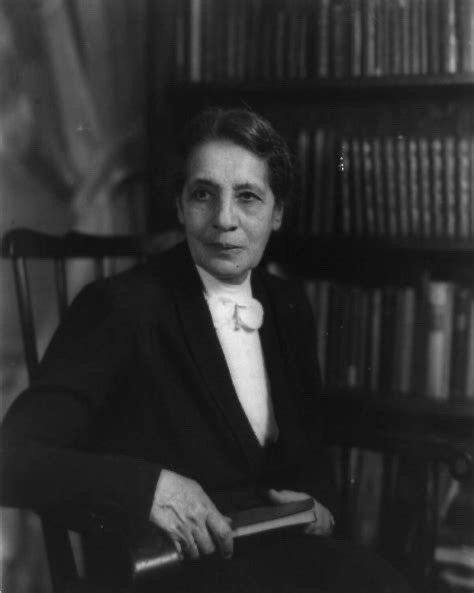
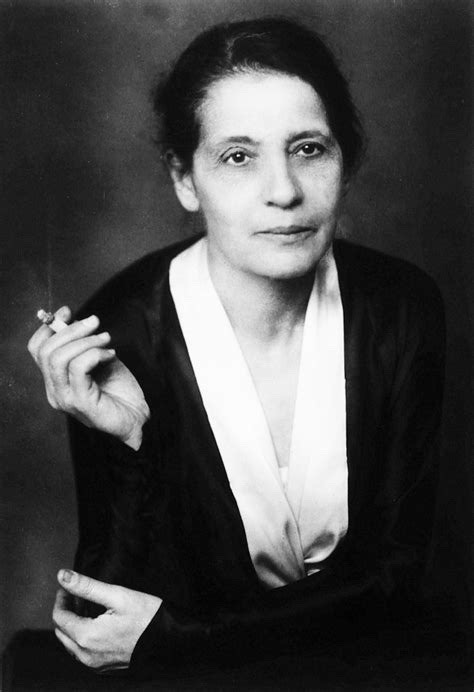
6 notes
·
View notes
Text
Science makes people reach for truth and objectivity; it teaches people to accept reality, with wonder and admiration, not to mention the deep awe and joy that the natural order of things brings to the true scientist.
-Lise Meitner
Comment: Lise Meitner was probably the first person to calculate and understand the energy that an uncontrolled nuclear fission (chain reaction) could release and what that could mean.
5 notes
·
View notes
Text
I got a 100 postcard pack all about historical/famous women scientists with little facts about them on the fronts.
They were super salty with this one, lol
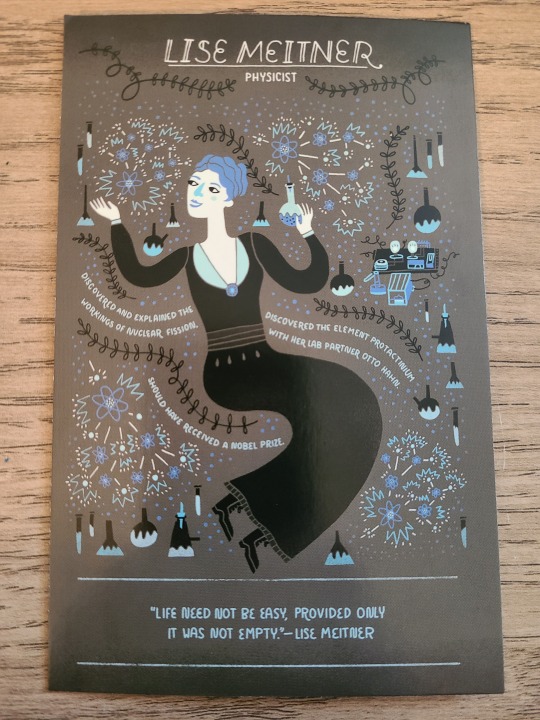

6 notes
·
View notes
Text
The New York Times Lise Meitner, the ‘Atomic Pioneer’ Who Never Won a Nobel Prize

View On WordPress
2 notes
·
View notes
Note
omg you named your cat after lise meitner???
Yes! Her name is Meitner and we call her Mighty for short.
She's adorable AND I get to tell people about Lise Meitner when they comment that it's not a name they've heard for a cat before.

Previous cats were Schroedinger and Archimedes so there's a bit of a science and history theme.
4 notes
·
View notes
Photo
Entirely too many of these tags had no autocomplete. Note to self: fix that.
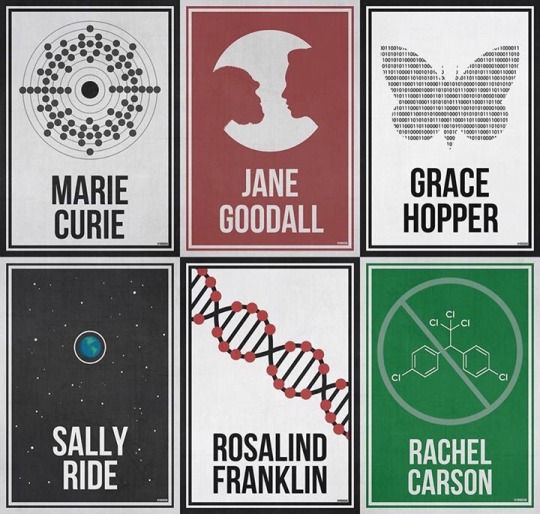
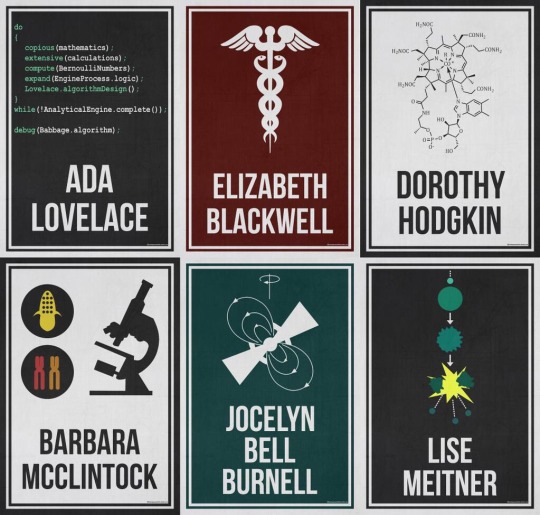
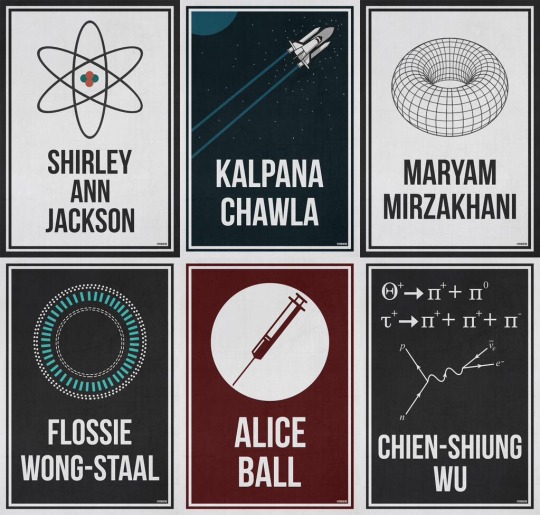
The complete ‘Women Who Changed Science - And The World" collection in honor of the 95th Women’s Equality Day.
Purchase Here!
#politics#science#marie curie#jane goodall#grace hopper#sally ride#rosalind franklin#rachel carson#ada lovelace#elizabeth blackwell#dorothy hodgkin#barbara mcclintock#jocelyn bell burnell#lise meitner#shirley ann jackson#kalpana chawla#maryam mirzakhani#flossie wong-staal#alice ball#chien-shiung wu#mathematics#computer science#ada
125K notes
·
View notes
Text
Life need not be easy, provided only it was not empty.
- Lise Meitner, in Women in Science: 50 Fearless Pioneers Who Changed the World, Rachel Ignotofsky
#books books books#ich#psychology#psychblr#uni#reading#currently reading#book#books#book quotes#women in science#lise meitner#rachel ignotofsky
1 note
·
View note
Text
I keep coming back to this article from 2021 because it's an important topic.
It does mention, that for a while the centre of the scientific world was in Germany and one needed to know German to be a physicist-something the Nazis ruined forever.
It talks about how the United States became the centre of the scientific world after WWII and that cemented the place of English. I think that's problematic not just because of cultural Americentrism, but also because even if many prestigious universities and research institutes are in the United States, the reality is that the American people as a whole don't care about science, and the American government does not fund science as much (scaled to population) as in many European countries, South Korea, Israel, China (probably some other countries I'm forgetting).
The position of English as the only language of physics is problematic also because so many people can't read or write scientific papers in their own language (or in some countries, learn physics in their native language), but I'm not sure what the solution is, and this article does little to suggest a solution. In the late 19th century, western physicists needed to have a working knowledge of English, French and German to do physics. Today, with people around the world collaborating on physics papers and going to conferences, and with little barriers to collaboration between western and non-western scientists, one might need to have a working knowledge of 4-8 languages just to keep up with their narrow subfield of physics were it not for everything being in English.
#linguistics#physics#germany#german#americentrism#robert oppenheimer#enrico fermi#lise meitner#albert einstein#maria goeppert mayer#werner heisenberg#ussr#history
1 note
·
View note
Text
Intresting
To go back to early december. Anne L'Huillier who got the nobel prize in physics is called the second French woman to get the nobel prize in physics after Marie Skłodowska* Curie. The thing is that wikipedia calls her “French-Swedish physicist”, so Anne L'Huillier should also be the first Swedish woman who got the prize? Sure if you know your science history, you know that the Austrian Swedish physicist Lise Meitner should have shared the prize in 1944 because of her hypothesis about nuclear fission. But apparently back in the days you couldn’t be a woman and get a scientific nobel prize unless your last name was Curie, that’s another story. The third story might be that Lise Meitner ended up in Stockholm when it seems like all other Jewish scientists from Central Europe emigrated to the US (largest brain gain in history?).
* According to a Polish Swedish guy I knew, Marie Skłodowska Curie was very keen on keeping her Polish name.
0 notes
Text
Science makes people reach for truth and objectivity; it teaches people to accept reality, with wonder and admiration, not to mention the deep awe and joy that the natural order of things brings to the true scientist.
-Lise Meitner
0 notes
Text
Who cares about Oppenheimer, let’s talk about Lise Meitner!!!
She was the first to name and explain nuclear fission, but she was passed over for the Nobel Prize in favor of her collaborator Otto Hahn. She planned experiments in secret after having to flee Austria during WWII because she was Jewish. When she was asked to join the Manhattan Project, she refused on moral grounds. Her tombstone reads “A physicist who never lost her humanity.”
Lise Meitner is one of the most important scientists of the 20th century, and she’s rarely ever mentioned.
Some articles about her:
1 note
·
View note
Text
In my opinion, this is precisely the great moral value of scientific education, that we must learn to have reverence for the truth, regardless of whether or not it agrees with our desires or preconceived opinions.
-Lise Meitner
Comment: Lise Meitner was a pacifist throughout her life - but it got soon clear to her that one day the knowledge about nuclear fission could also be used for a weapon.
0 notes